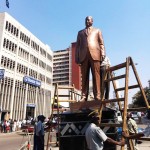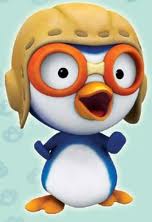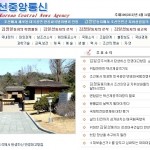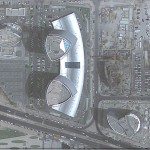
UPDATE 2 (2011-5-12): Zanu-PF has decided to re-erect the Nkomo statue. According to the Zimdiaspora:
The controversial statue of the late vice president Joshua Mqabuko Nyongolo Nkomo will be re-erected in Bulawayo’s city centre after Zanu PF bigwigs agreed to put up the giant North Korean designed effigy.
Zanu PF officials said President Robert Mugabe appointed Environment Minister Francis Nhema who is Nkomo’s son-in-law to be in charge of the raising of statue along Main Street.
The statue was removed last year following widespread outcry by the Nkomo family but latest details show that the family has backtracked following Nhema’s persuasion. The soft-spoken Nhema is married to Louise Sehlule, one of the late nationalist’s daughters.
In the past two months, sources said Nhema, who chairs the Joshua Nkomo Foundation, has been making frequent visits to Bulawayo where he also met senior politicians to lobby for the re-erection of the statue, which drew anger from the Nkomo and Bulawayo community because it was made in North Korea—a country known for training the notorious 5th Brigade soldiers who killed over 20 000 civilians, raping 60,000 women.
Nhema met vice president John Nkomo, politburo members, Joshua Malinga, Eunice Sandi and Angeline Masuku as he drummed up support for the statue to be re-erected.
After the uprooting of the statue, it was later agreed that it would be put at the Joshua Mqabuko Nkomo airport on the outskirts of Bulawayo but there were reservations that the public would not be able to view it since it will be kilometers away.
“It’s a matter of time before the statue is put back along Main Street. Zanu PF doesn’t want to be seen as failures by conceding to pressure from the Nkomo family and the people of Matabeleland,” said a top Zanu PF official.
The latest revelation to re-erect the statue comes against a backdrop of efforts by former Zipra commanders to block the move, saying Mugabe, 87, should first return Zipra buildings to its rightful owners. Some of the buildings include Magnet House, which houses the dreaded CIOs in Bulawayo.
Although Nhema was not answering his mobile phone Thursday, a politburo meeting Wednesday vowed that the statue would be erected again.
UPDATE 1 (2011-1-23): The statue was mentioned in this New York Times article
ORIGINAL POST (2010-9-17): According to MonstersandCritics.com:
Public anger over a decision to allow a North Korean firm to make a statue of a Zimbabwean freedom fighter resulted in government plans to take it down before its unveiling, according to reports Thursday.
The three-metre bronze statue of Joshua Nkomo had been under threat by the family of the deceased leader of the Ndebele ethnic group. They had vowed to tear it down, angered that the Zimbabwean subsidiary of a North Korean company had created it.
In the mid-1980s, North Korean military instructors, invited by President Robert Mugabe, trained a brigade that went on to kill thousands of Ndebele citizens during a low-intensity insurgency.
‘It was highly insensitive of the government to have hired the North Koreans to produce the statue without consulting Nkomo’s family or the people of Matabeleland,’ said political analyst Grace Mutandwa. ‘Let’s just say the North Koreans are not the Ndebele’s favourite people.’
After its completion, the statue remained covered by a black cloth on a plinth until Home Affairs Minister Kembo Mohadi removed the shroud Wednesday, announcing plans to dismantle it ‘with immediate effect.’
Originally, Mugabe had planned to participate in a public unveiling of the statue.
In the 1960s, Nkomo became the first national leader of the fight by blacks against the white minority government of Ian Smith. He led a rival faction to Mugabe’s in the 1970s before independence in 1980 and Mugabe’s election as prime minister.
Shortly after, Mugabe accused Nkomo and his ZAPU party of being behind an insurgency and launched a crackdown in western Zimbabwe, in which thousands of civilians were killed or disappeared. Nkomo died of prostate cancer in 1999, aged 82.
This is not the first time this year the Ndebele have protested over North Korea’s relations with Zimbabwe.
The North Korean national football team had been due to train in Bulawayo before the World Cup in neighbouring South Africa in June and July, but the visit was called off after Ndebele groups vowed to disrupt their training.
And according to Zimeye:
[A] statue of the late Vice President Joshua Nkomo was unveiled on Wednesday, but a minister said it would be immediately pulled down “following objections by his family and the Bulawayo community”.
A family spokesman said the statue, mounted at the intersection of Main Street and 8th Avenue was “small and pitiful”.
Home Affairs Minister Kembo Mohadi met Nkomo’s family for four hours on Tuesday as he unsuccessfully tried to reach an agreement on the three-metre-tall bronze statue which was erected over a month ago, and remained covered in a black cloth until Wednesday.
The meeting in Harare was also attended by Vice President John Nkomo, a relative of the late nationalist leader who died in July, 1999. Mohadi revealed John Nkomo was joined in the objections with the rest of the family.
Mohadi, who attended Wednesday’s unceremonious unveiling, said: “I have come here with bad news … to tell you that we will pull down and dismantle this statue with immediate effect.
“From the day when this statue was erected, the family objected and we have been receiving calls as to when the statue will be dismantled.
“We made extensive consultations and apparently Vice President John Nkomo shares the same sentiments with them, and as such we are complying with the wishes of the Nkomo family to remove the statue.”
Mohadi has refused to say where the statue was made and at what cost, although some reports say it was cast by a North Korean artist. It will be removed to the National Museum.
A senior government source revealed Mohadi had spoken to President Robert Mugabe after the tense meeting with Nkomo’s family.
“The President told Mohadi to ‘leave them (Nkomo’s family)’. He also said he was disappointed with John Nkomo for failing to take a principled stand,” the source said.
Mohadi, whose ministry commissioned two statues – the other designated for Harare – appeared to take the failure to get the statue to stand in Bulawayo personally.
He said: “It is unfair to myself and the ministry because we thought this was a government project that we initiated in honour of Dr Nkomo, but because the family objects to it we find it proper to concede to their plea and have no option but to abandon the project.
“With me, it is the end of the project indefinitely and I do not think we will do anything about it. The budget on it has been wasted.”
Mohadi disclosed contents of an August 31 letter he received from Nkomo’s daughter Thandiwe outlining 11 points of objection.
The family said there was no consultation on the final prototype, characteristics, and proposed locations of the statue.
“The statue itself is very small and pitiful, hardly a street statue at all nor the landmark and monument that it should be,” the family added.
The design of the statue said nothing about Nkomo and his historical legacy, the letter went on, and the size and colour of the 1,2 metre pedestal it was installed on “does not match the lofty stature of the late Father Zimbabwe.”
The family said it was not objecting to the principle of immortalising Nkomo with a statue, but wanted adequate consultations before work on a new one commenced. The family also wants the statue installed at the Joshua Mqabuko Nkomo International Airport in Bulawayo.
The planned erection of a second statue in Harare — already mired in legal troubles — now appears unlikely to go ahead. The owners of the Karigamombe Centre, the proposed site of the statue, have obtained a court order stopping the erection.
This story was eventually picked up by the Associated Press on September 29th:
The two North Korean-made statues were meant to honor a national hero but people were so offended because of Pyongyang’s links to a blood-soaked chapter of Zimbabwe’s history that one was taken down almost immediately and the other has not been erected.
Besides, at least one of them didn’t even resemble Joshua Nkomo, a former guerrilla leader known as “Father Zimbabwe” who died in 1999 at the age of 82.
That the statues were designed and made by North Koreans is an affront to Zimbabweans who blame North Korean-trained troops loyal to President Robert Mugabe for massacring thousands of civilians as the government tried to crush an uprising led by Nkomo in the 1980s. The uprising ended when Nkomo signed a unity pact in 1987 and became a vice president.
No offense was intended by the choice of North Korea to make the statues, Godfrey Mahachi, head of the state National Museums and Monuments, told The Associated Press. He said North Korea was chosen simply because it won the bid for the work, promising favorable prices.
One of the Nkomo statues was erected briefly last month in Bulawayo, Zimbabwe’s second-biggest city, on the site where a statue of British colonial era leader Cecil John Rhodes once stood. Nkomo’s family called his statue artistically “ineffectual.”
While there were no organized protests, criticisms were widespread before the unveiling. Nkomo’s relatives were quoted in newspapers complaining that they had not been consulted. Simon Dube, a Bulawayo businessman, said the Nkomo statue was shrouded under a black cloth under police guard. Dube, who glimpsed it, said the statue’s head was too small for Nkomo’s famously heavy and imposing build.
Organizers kept the police on hand during the unveiling ceremony and took the statue down within hours.
The other statue was to have been placed in the capital, Harare, outside an office tower known as Karigamombe, which in the local Shona language means “taking the bull by the horns and slaying it.” Some saw that as adding insult to injury: the symbol of Nkomo’s Zimbabwe African People’s Union party and his former guerrilla army was a rampaging bull.
Home Affairs Minister Kembo Mohadi said that despite the kerfuffle, the North Koreans have been paid their $600,000 for the two statues, state media reported.
Mahachi said officials are considering where else to put the two 3-meter (10 foot) statues.
“We still have to look at different options. They might go to museums, but that will be discussed to reach a final decision,” he said.
The Bulawayo statue is for the time being kept at the Bulawayo Natural History Museum, where the deposed statue of Rhodes is also kept.
Nkomo spent his adult life fighting colonialism and was also imprisoned for a decade for his political activism against white rule in Rhodesia, as Zimbabwe was previously called. “Father Zimbabwe” spearheaded black nationalist resistance to white rule well before Mugabe came on the scene. Nkomo’s image has appeared on postage stamps and the Bulawayo international airport has been named after him.




